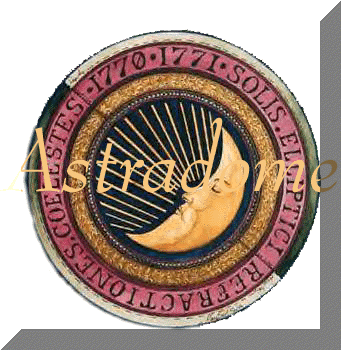|
Artist - Edward
Robert Hughes
For millions of years the Moon, a bare,
spherical chunk of rock, solitary and unwavering, has circled the Earth -
our home. The gravitational force affects every point on the Earth -
and hence every human being, every animal, every plant, every atom on our
planet.
Moscow is raised and lowered by
twenty inches twice a day by the tides, those mysterious currents that
visibly affect the oceans of the Earth, which in turn are affected
directly by the Moon. The Moon acts as a magnetic force on Earth, pulling
the waters towards it. Some areas, such as the Mediterranean, have
no tides, while in other areas there are many complex local variations to
the tides. This is because the Earth is not a uniformly smooth ball,
but is covered with things like continental shelves and oceanic basins,
which have their own specific effects.
In times past, numerous calendars were
designed according to the path of the Moon. Today, many festivals
are still adjusted to its position as is Easter, which, since the
end of the second century, has been celebrated on the first Sunday
after the first full Moon after the beginning of Spring.
The Greeks contributed an immense amount to man's
knowledge of the Moon - and of astronomy. It was they who recognized that
the Moon shone by reflecting the Sun's light and that only half its
surface could be lit by the Sun. They even figured out the changing
phases of the Moon were the result of its changing position in relation to
the Sun. (Thus, the ego (Sun), symbolic of our confidence and
sense of Self, greatly influences how we tend to feel about
ourselves).
Each month we see the Moon going through its extraordinary, never-ending
process of transformation. It appears out of the darkness, a fragile
silver of light, and grows imperceptibly until it reaches the glory of its
maturity; then slowly but inevitably fades back into the night. We
feel its pull on the waters and life of Earth, and its rhythms seem
connected with our own most hidden and mysterious ones - those of
fertility, creation, of life itself. Little wonder that myths and
legends surrounding the Moon are found in all cultures throughout the
ages.
The Moon sign shows how we defend ourselves instinctively:
 Moon in Fire (Aries, Leo Sagittarius) reacts with anger
Moon in Fire (Aries, Leo Sagittarius) reacts with anger
 Moon in Air
(Gemini, Libra, Aquarius) with rationalization, discussion, or argument Moon in Air
(Gemini, Libra, Aquarius) with rationalization, discussion, or argument
 Moon in Water
(Cancer, Scorpio, Pisces) with retreat or emotional outpourings Moon in Water
(Cancer, Scorpio, Pisces) with retreat or emotional outpourings
 Moon in Earth
(Taurus, Virgo, Capricorn) with endurance Moon in Earth
(Taurus, Virgo, Capricorn) with endurance
There are volumes of
literature one can avail oneself to for more information on the Moon and
its rich astrological and mythical symbolism.

|
Are you
aware that the Moon generates a magnetic pull on Earth affecting
the fluids in our bodies, female menses, the tides of the oceans - and our
emotions? It's a scientific fact.
If you are reading this article you were probably
fascinated by the adjacent painting. How insightful of the artist to title
it "The Weary Moon" . At close observation, one
notices the interchangeable pictures of a feminine body - a woman - and
then - the Moon. Since the Moon is a symbol of the
emotions, the indication is clear that emotions (considered the
feminine energy of the anima in the psyche) will make us very weary at
times. I wondered if Hughes was knowledgeable of
Astrology?
Michel Gauquelin, renowned for
his extensive scientific research into the claims of Astrology, reported
how the different phases of the Moon affects our behavior in day to day
life:
New Moon: beginnings, hidden
changes, chaos and disorganization, confusion, rest
Full Moon: completion, fulfillment, activity, unrest, awareness
These can be further broken down:
1st quarter: beginnings, outward-going, germination and
coming forth
2nd quarter: the development of things which have already
started
3rd quarter: completion and maturity, fullness
4th quarter: rest and introspection, disintegration before
new beginnings

|
|